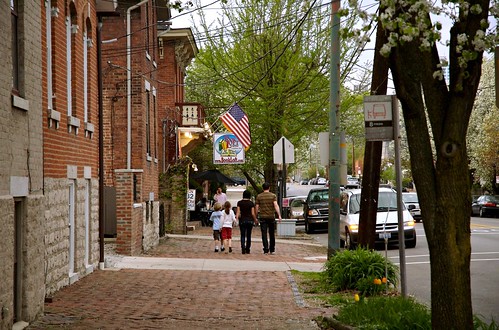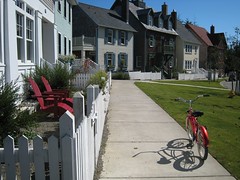Walkable neighborhoods have higher levels of trust, community participation

Posted December 15, 2010 at 1:30PM
A study by the Natural Resources and Earth System Science program at the University of New Hampshire finds that residents of neighborhoods with walkable access to shops and services have “higher levels of social capital such as trust among neighbors and participation in community events,” according to lead researcher Shannon Rogers.
The study, “Examining Walkability and Social Capital as Indicators of Quality of Life at the Municipal and Neighborhood Scales,” is published in a recent issue of the journal Applied Research in Quality of Life (abstract and for-pay access to full article here). Rogers and the study’s coauthors surveyed 700 residents of 20 neighborhoods in two New Hampshire municipalities, Portsmouth and Manchester.
Survey participants self-identified the walkability of their neighborhoods by indicating the number of locations they could walk to in their community; any neighborhood with a mean response of more than seven walkable locations (out of a possible 13) was designated “walkable” by the researchers. To measure social capital, they utilized a well-established scale developed by the Saguaro Seminar at Harvard University, which is headed by Bowling Alone author and social capital scholar Robert Putnam.
According to the University’s press release, “those living in more walkable neighborhoods trusted their neighbors more; participated in community projects, clubs and volunteering more; and described television as their major form of entertainment less than survey participants living in less walkable neighborhoods.”
The research is consistent with findings from Lewis and Clark University research studying residents’ habits in the smart-growth development Orenco Station in Hillsborough, Oregon. As noted in a previous post, Orenco residents consistently reported more friendliness, more "community," and more group participation than in their previous communities. Walkable neighborhoods have also been found to foster physical fitness and enjoy higher home values than less walkable districts.
The New Hampshire research was funded in part by the U.S. Environmental Protection Agency under the Science to Achieve Results (STAR) Graduate Fellowship Program. In addition, Rogers and Carlson received support from the University of New Hampshire’s Sustainability Fellowships to the Environmental Research Group.
Move your cursor over the images for credit information.


